Alcamo Marina
Alcamo Marina is a seaside resort in the north-western part of Sicily and in the town territory of Alcamo. It is situated 6 km far from it,[1] about 5 km from the small town of Castellammare del Golfo,[1] 16 km from the village of Scopello, and 49 km from the famous seaside resort of San Vito Lo Capo. Alcamo Marina is characterized by a very fine, golden sand beach[1] about 10 km long, absolutely free (except for some little tracts that people can cross near hotels, lidos, etc.).
Alcamo Marina | |
|---|---|
Hamlet | |
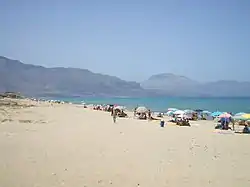 Alcamo Marina’s beach | |
| Coordinates: 38.028°N 12.937°E | |
| Country | Italy |
| Region | Sicily |
| Province | Trapani |
| Elevation | 52 m (171 ft) |
| Time zone | +1 |
| Area code | 0924 |
During the summer season Alcamo Marina is very populated: in fact there are a lot of holiday houses (both near the beach and on the hills overlooking it), a hotel and various bed and breakfast.
Geography
Territory
The territory of Alcamo Marina is bounded by the stream Finocchio on the east (near Balestrate), the river San Bartolomeo on the west (near Castellammare del Golfo), the Tyrrhenian Sea on the north and Alcamo on the south.[2] Going from east towards west, the territory of Alcamo Marina is subdivided into different "zones":
- " Contrada Calatubo" (called also zona Aleccia by residents), including the wood "Le macchie" near the beach and the remains of an ancient castle (called "castello di Calatubo" too), located in the area between Alcamo and Balestrate;
- "Contrada Canalotto"; with the so-called “fosso Canalotto"in the middle and the deep valley Molinella separating it from contrada Calatubo. The area further west is called "zona Battigia" by residents;
- "Contrada Plaia";
- "Contrada Magazzinazzi", about a hundred metres before the river San Bartolomeo, connecting Alcamo Marina to the beach of Castellammare del Golfo (in Trapani Province).
- "Contrada Foggia", south of contrada Magazinazzi.
The streams Giovenco, Placati and Stellino cross this territory from south northwards.
Alcamo Marina is crossed by the railway Palermo-Trapani, which runs near the beach. The railway bounds a narrow strip more downhill, nearer to the sea which is called "sotto linea" (that is "below the railway"), while the biggest part of Alcamo Marina’s territory is situated above the railway and is called "sopra linea"(that is "above the railway"). Pedestrians can cross the railway through different flyovers and subways, while cars and motorbikes can cross it through level crossings and an underpass near the Battigia zone.
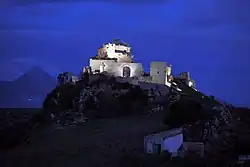
.jpg.webp) Gigli marini
Gigli marini Sunset at contrada Canalotti
Sunset at contrada Canalotti The beach at contrada Magazzinazzi
The beach at contrada Magazzinazzi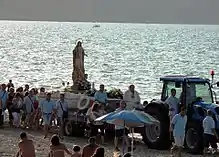 Procession of Maria Santissima Assunta, 15 August
Procession of Maria Santissima Assunta, 15 August
History
Origins
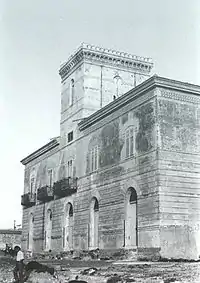
The construction of its first buildings was related to its being a location for tuna fishing.
The "sack" of Alcamo Marina
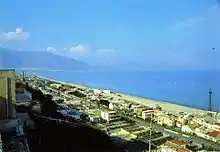
At first sight the area of Alcamo Marina looks like a huge "wood of houses" leaning on the long and near beach and on the fragile hills lying behind made of recent limestones and sandstones.
At the end of the fifties and beginning of the sixties, as happened with the "sack of Palermo", this area was actually sacrificed to a big property speculation and to unauthorized building, with consequences which did not delay to arrive. In fact, in addition to the damage done because of the non-exploitation of this area for touristic purposes, there were also the environmental deterioration produced by the striking urban migration and the structural damages arising for the existing buildings, above all in those which had been built on the slopes with a high risk of hydrogeological instability,[2][3] already showing widespread signs of structural failure which oblige the owners to frequent and expensive works to make their houses safe.
Several criticisms have been moved at the time to the choice of lotting out the waterfront to build, because it would have been more correct to make a choice for a promenade serving the bathing area with a limited number of private houses in favour of hotel facilities which would have been more profitable (both on short and long term) and would have given a huge economic and occupational return thanks to the characteristics of the surrounding territory and the length of this beach.[2]
The carabinieris' small post slaughter
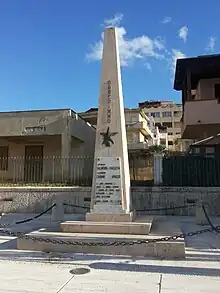
On 27 January 1976 it occurred the so-called "Alcamo Marina's slaughter": two carabinieris, the nineteen years old Carmine Apuzzo and the lance-corporal Salvatore Falcetta, were killed while sleeping in the small post.[4]
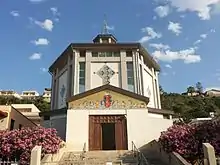
Attempts of the environment revaluation
In 2011 they inaugurated a long wooden platform in Alcamo Marina, built in order to give an access to the beach to disabled people too.[2] However it was destroyed by the winter sea storms and it has become the subject of debates.[5]
Since June 2014, the streets of Alcamo Marina were provided by toponyms.[6]
Main sights
Religious buildings
At Alcamo Marina there is the Chiesa di Santa Maria della Stella (also called "Stella Maris"), with a central body with a poliedric plan; you can go inside it by passing through a portal which is surmounted by a mosaic representing Santa Maria della Stella.
There is also an old small church near the Tonnara (in the Battigia area). You can also attend Mass at the Oasi Maria Regina della Famiglia locatednext to Piazzale Canalotto.
Archeological sites
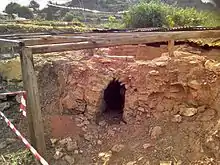
Near contrada Magazinazzi, further to the excavations made between 2003 and 2005,[7] they found the remains of old Roman furnaces which were used for the production of tiles and bricks.[1]
Paleontologic sites
The territory of Alcamo Marina is full of fossil shells dating back to the Inferior Pleistocene and belonging to the geologic formation called "Sintema of Marsala".[8] Some of the present species are: Artica islandica, Chlamis multistriata and Ostrea.[8]
For this purpose, on 15 July 2014 at Alcamo Marina (in the Calatubo zone) they created a geologic point and a paleontologic laboratory called "Fossilandia".[9]
Natural areas
The sea lily, a plant of the family Amaryllidaceae blooming in summer,[1] grows on the dunes of Alcamo Marina.
Other plants naturally growing on the coastal dunes in Alcamo Marina are Cakile maritima and Agropyrum junceum.[10] The seeds of these plants are transported here by the wind.[10]
Economy
As Alcamo Marina is a seaside resort, the main economic activities are based on entertainments and restoration (rented holidays houses, pizzerias, restaurants and bars).
Transports and infrastructures

By car - Alcamo Marina is served by the A29 Motorway Palermo-Mazara del Vallo with two junctions: Alcamo Est (at about 3 km distance) and Castellammare del Golfo (at about 4 km).
Trains - The railway station of Castellammare del Golfo (at about 3 km from the centre of Alcamo Marina) is situated on the railway line Palermo-Trapani and is connected to Alcamo Marina and Alcamo by buses in the summer season.
Buses - The town bus Alcamo-Alcamo Marina runs since 15 June until September with different stops, including the railway station. Besides there are coaches for Palermo and San Vito lo Capo stopping at Alcamo Marina.
Alcamo Marina is at about 40 km. far from "Falcone-Borsellino" airport at Palermo-Punta Raisi and about 50 km. from the airport "Vincenzo Florio" at Trapani-Birgi.
See also
Notes
- "Comune di Alcamo - Alcamo Marina". Archived from the original on 3 April 2015. Retrieved 6 May 2015.
- Quando il "buonsenso edilizio" scompare: Alcamo Marina
- "Quotidiano Locale - Dissesto idrogeologico, allarme rosso su Alcamo Marina". Archived from the original on 8 January 2015. Retrieved 6 May 2015.
- Apuzzo e Falcetta: ieri, la commemorazione dei Carabinieri uccisi nella strage di Alcamo Marina
- Le dichiarazioni di Sucameli su Turano e la passerella di Alcamo Marina finiscono in Procura
- Arriva la toponomastica ad Alcamo Marina
- Gruppo Archeologico Drepanon 2014, p. 19.
- "Comune di Alcamo - Collezione di fossili del Sig. Vincenzo Gruppuso di Alcamo". Archived from the original on 3 April 2015. Retrieved 6 May 2015.
- Fossilandia - Comunicato Stampa
- Non toccate le dune di Alcamo Marina!
References
- Gruppo Archeologico Drepanon (2014). Bonifato - La montagna ritrovata (in Italian). Trapani: Il Sole editrice. ISBN 978-88-905457-3-3.
- Di Piazza, Michele; Orofino, Giacomo A.; Fiori, Cesare (2012). Le fornaci romane di Alcamo. Rassegna, ricerche e scavi 2003-2005 F(a cura di D.Giorgetti). Roma: Aracne. ISBN 885-48-05963.
- Giorgetti, Dario; Muro, Xabier Gonzalez (2011). Le fornaci romane di Alcamo. Rassegna di studi e ricerche 2006/2008. Catalogo dei materiali" a cura di Dario Giorgetti e Xabier Gonzalez Muro. La Mandragora. ISBN 887-58-62524.